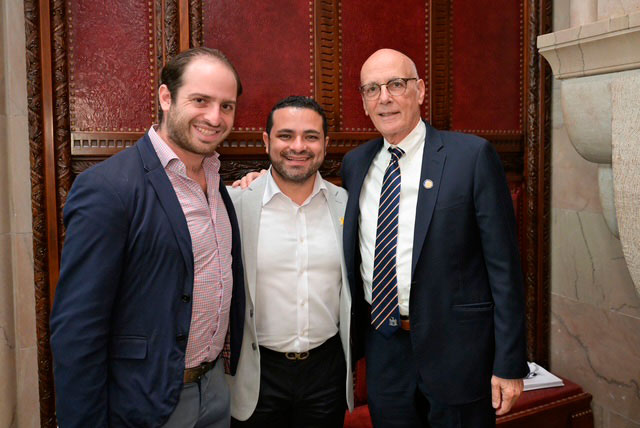ByEddie Esses and Sari Setton
On the evening of May 20, nervous anticipation quickly turned into excited euphoria… that we had finally done it. That WE, as a community, had achieved something monumental.
In a historic moment for the Sephardic Jewish Community, Sam Sutton was elected to lead the 22nd New York State Senate District with a commanding 67-32% margin – making him the first Sephardic Jew ever elected to the NY State Senate. This was much more than just a victory for Sam; it was a transformative milestone for our community, which has steadily grown in strength, unity, and civic engagement.
This victory was reached, thanks in large part to our community. Special elections in non-presidential years often see minimal voter participation, but the Sephardic Community turned out in force. Building on the momentum of Joey Saban’s groundbreaking campaign for New York State Assembly just one year ago, we once again demonstrated that we are organized, motivated, and ready to be taken seriously by elected officials at every level. Borough Park, Midwood, and Flatbush voters also came out strong for Sam by a wide margin, contributing to a diverse and powerful coalition.
The election night celebration reflected the joy and meaning of this historic achievement. Sam gathered with close friends, campaign team members, and a host of dignitaries and elected officials. Former Governor Andrew Cuomo, Manhattan Borough President Mark Levine, and many NYC Council Members offered heartfelt remarks, reflecting on their past work with Sam and highlighting his long standing reputation as a thoughtful, effective, and principled leader. Ronnie Tawil, Sam’s fellow co-founder of the Sephardic Community Federation, gave a moving tribute, speaking of Sam’s unwavering devotion to the community and his decades of quiet yet impactful leadership.
In his remarks that evening, Sam made sure to thank everyone who made the victory possible – but he gave special thanks to his wife, Nancy, a community leader in her own right. Sam acknowledged how much of his communal involvement was inspired and shaped by Nancy’s tireless work, and how grateful he is for her support, wisdom, and example.
Sam’s leadership has deep roots. A lifelong community leader, he has spent decades shaping key community institutions. He served over 30 years at SBH, including five as president, helping it grow into a comprehensive social service powerhouse. He co-founded and still chairs Teach NYS, which secured a $330 per-child education tax credit and opened the door for yeshivot to receive Title I services from culturally appropriate third-party providers. As a founding board member of the SAFE Foundation, a trustee at NYU Langone Hospital, and a former CUNY Board of Trustees member, Sam has spent his life using institutional roles to deliver tangible results for our community.
Behind the scenes, the campaign ran on passion, dedication, and a clear vision. Campaign manager Joey Saban, whose own run for office catalyzed a wave of civic engagement in the community last year, worked nonstop for months to line everything up for a potential campaign. Once launched, he ensured every detail of the campaign strategy was executed with heart and precision. That same energy carried through to Election Day, where Sephardic Community voters sent a clear and powerful message: we are no longer on the sidelines—we are shaping the future.
Only one week after the election, Sam took office in a special ceremony on the floor of the State Senate. Alongside his wife Nancy and his entire family, Sam was sworn into office using the Aleppo Codex, showcasing just how monumental a feat was achieved. Sam was recognized later that day during his first legislative session with a round of applause by the entire chamber.
True to character, Sam wasn’t looking to spend time basking in his victory. He was eager to get to work. With just two weeks remaining before the end of the legislative session, Sam introduced four of his own bills and passed three of them (!) – that’s more than many legislators pass in their full terms. One bill prevents the issuing of sanitation tickets to those who put out their garbage on Friday as opposed to during Shabbat. Another bill supports funding for treatment for those struggling with infertility. In addition to passing multiple bills at a record pace, Sam also secured significant funding for multiple community organizations.
For our community, this endeavor was much more than an election – it was a moment of long-overdue recognition. The Sephardic community has shown that it is cohesive, active, and ready to build lasting influence with government. With Sam Sutton in the State Senate, our voice is finally where it belongs: at the table.












